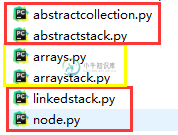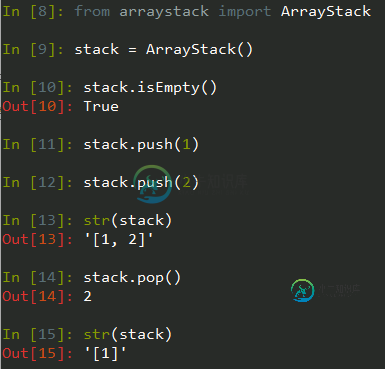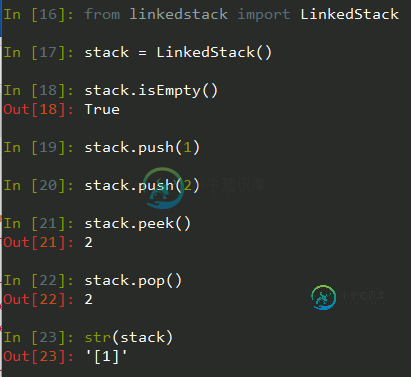Python实现栈的方法详解【基于数组和单链表两种方法】
本文实例讲述了Python实现栈的方法。分享给大家供大家参考,具体如下:
前言
使用Python 实现栈。
两种实现方式:
- 基于数组 - 数组同时基于链表实现
- 基于单链表 - 单链表的节点时一个实例化的node 对象
完整代码可见GitHub:
https://github.com/GYT0313/Python-DataStructure/tree/master/5-stack
目录结构:

注:一个完整的代码并不是使用一个py文件,而使用了多个文件通过继承方式实现。
1. 超类接口代码
arraycollection.py
"""
File: abstractcollection.py
Author: Ken Lambert
"""
class AbstractCollection(object):
"""An abstract collection implementation."""
# Constructor
def __init__(self, sourceCollection = None):
"""Sets the initial state of self, which includes the
contents of sourceCollection, if it's present."""
self._size = 0
if sourceCollection:
for item in sourceCollection:
self.add(item)
# Accessor methods
def isEmpty(self):
"""Returns True if len(self) == 0, or False otherwise."""
return len(self) == 0
def __len__(self):
"""Returns the number of items in self."""
return self._size
def __str__(self):
"""Returns the string representation of self."""
return "[" + ", ".join(map(str, self)) + "]"
def __add__(self, other):
"""Returns a new bag containing the contents
of self and other."""
result = type(self)(self)
for item in other:
result.add(item)
return result
def __eq__(self, other):
"""Returns True if self equals other,
or False otherwise."""
if self is other: return True
if type(self) != type(other) or \
len(self) != len(other):
return False
otherIter = iter(other)
for item in self:
if item != next(otherIter):
return False
return True
abstractstack.py
"""
File: abstractstack.py
Author: Ken Lambert
"""
from abstractcollection import AbstractCollection
class AbstractStack(AbstractCollection):
"""An abstract stack implementation."""
# Constructor
def __init__(self, sourceCollection = None):
"""Sets the initial state of self, which includes the
contents of sourceCollection, if it's present."""
AbstractCollection.__init__(self, sourceCollection)
# Mutator methods
def add(self, item):
"""Adds item to self."""
self.push(item)
2. 基于数组
运行示例:

代码:
栈实现:arraystack.py
"""
File: abstractstack.py
Author: Ken Lambert
"""
from abstractcollection import AbstractCollection
class AbstractStack(AbstractCollection):
"""An abstract stack implementation."""
# Constructor
def __init__(self, sourceCollection = None):
"""Sets the initial state of self, which includes the
contents of sourceCollection, if it's present."""
AbstractCollection.__init__(self, sourceCollection)
# Mutator methods
def add(self, item):
"""Adds item to self."""
self.push(item)
数组实现:arrays.py
"""
File: arrays.py
An Array is a restricted list whose clients can use
only [], len, iter, and str.
To instantiate, use
<variable> = array(<capacity>, <optional fill value>)
The fill value is None by default.
"""
class Array(object):
"""Represents an array."""
def __init__(self, capacity, fillValue = None):
"""Capacity is the static size of the array.
fillValue is placed at each position."""
self._items = list()
for count in range(capacity):
self._items.append(fillValue)
def __len__(self):
"""-> The capacity of the array."""
return len(self._items)
def __str__(self):
"""-> The string representation of the array."""
return str(self._items)
def __iter__(self):
"""Supports iteration over a view of an array."""
return iter(self._items)
def __getitem__(self, index):
"""Subscript operator for access at index."""
return self._items[index]
def __setitem__(self, index, newItem):
"""Subscript operator for replacement at index."""
self._items[index] = newItem
3. 基于链表
运行示例:

代码:
linkedstack.py
"""
linkedstack.py
"""
from node import Node
from abstractstack import AbstractStack
class LinkedStack(AbstractStack):
"""基于单链表实现栈-链表头部为栈顶"""
def __init__(self, source_collection=None):
self._items = None
AbstractStack.__init__(self, source_collection)
def __iter__(self):
"""迭代-使用一个列表实现, 列表第一项为单链表的最后一项"""
def visit_nodes(node):
if node != None:
visit_nodes(node.next)
temp_list.append(node.data)
temp_list = []
visit_nodes(self._items)
return iter(temp_list)
def peek(self):
"""返回栈顶元素"""
self._prior_condition()
return self._items.data
def clear(self):
"""清空列表"""
self._size = 0
self._items = None
def push(self, item):
"""入栈"""
self._items = Node(item, self._items)
self._size += 1
def pop(self):
"""出栈"""
self._prior_condition()
old_item = self._items.data
self._items = self._items.next
self._size -= 1
return old_item
def _prior_condition(self):
if self._size == 0:
raise KeyError("The stack is empty.")
node.py
"""
链表结构的节点类
"""
class Node(object):
def __init__(self, data, next=None):
self.data = data
self.next = next
参考:《数据结构(Python语言描述)》
更多关于Python相关内容感兴趣的读者可查看本站专题:《Python数据结构与算法教程》、《Python加密解密算法与技巧总结》、《Python编码操作技巧总结》、《Python函数使用技巧总结》、《Python字符串操作技巧汇总》及《Python入门与进阶经典教程》
希望本文所述对大家Python程序设计有所帮助。
-
本文向大家介绍Python栈的实现方法示例【列表、单链表】,包括了Python栈的实现方法示例【列表、单链表】的使用技巧和注意事项,需要的朋友参考一下 本文实例讲述了Python栈的实现方法。分享给大家供大家参考,具体如下: Python实现栈 栈的数组实现:利用python列表方法 代码如下: 运行结果: 栈的长度: 4 items:['welcome', 'www', 'jb51', 'net
-
本文向大家介绍C语言单链表实现方法详解,包括了C语言单链表实现方法详解的使用技巧和注意事项,需要的朋友参考一下 本文实例讲述了C语言单链表实现方法。分享给大家供大家参考,具体如下: slist.h slist.cpp main.cpp 附:单链表优化版本 slist.h slist.cpp main.cpp 希望本文所述对大家C语言程序设计有所帮助。
-
本文向大家介绍Python双链表原理与实现方法详解,包括了Python双链表原理与实现方法详解的使用技巧和注意事项,需要的朋友参考一下 本文实例讲述了Python双链表原理与实现方法。分享给大家供大家参考,具体如下: 文章目录 Python实现双链表 单链表与双链表比较 双链表的实现 定义链表节点 初始化双链表 判断链表是否为空 双链表尾部添加元素 双链表头部添加节点: 双链表表头删除 双链表按位
-
本文向大家介绍python实现单向链表详解,包括了python实现单向链表详解的使用技巧和注意事项,需要的朋友参考一下 本文研究的主要是Python中实现单向链表的相关内容,具体如下。 什么是链表 链表顾名思义就是~链 链表是一种动态数据结构,他的特点是用一组任意的存储单元存放数据元素。链表中每一个元素成为“结点”,每一个结点都是由数据域和指针域组成的。跟数组不同链表不用预先定义大小,而且硬件支持
-
本文向大家介绍Numpy数组转置的两种实现方法,包括了Numpy数组转置的两种实现方法的使用技巧和注意事项,需要的朋友参考一下 Numpy数组转置很容易,两种写法 但是一维数组转置的时候有个坑,光transpose没有用,需要指定shape参数 输出结果为 可见原本一维数组的shape第二的纬度那个1是空的,指定了以后才能顺利地讲行向量转为列向量 以上这篇Numpy数组转置的两种实现方法就是小编分
-
本文向大家介绍PHP实现链式操作的三种方法详解,包括了PHP实现链式操作的三种方法详解的使用技巧和注意事项,需要的朋友参考一下 本文实例讲述了PHP实现链式操作的三种方法。分享给大家供大家参考,具体如下: 在php中有很多字符串函数,例如要先过滤字符串收尾的空格,再求出其长度,一般的写法是: 如果要实现类似js中的链式操作,比如像下面这样应该怎么写? 下面分别用三种方式来实现: 方法一、使用魔法函

